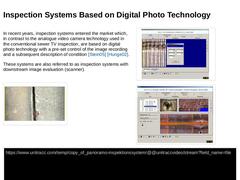
|
In recent years, inspection systems entered the market which, in contrast to the analogue video camera technology used in the conventional sewer TV inspection, are based on digital photo technology with a pre-set control of the image recording and a subsequent description of condition [Stein05] [Hunge02]. These systems are also referred to as inspection systems with downstream image evaluation (scanner). (Image: Recording of the condition image "pipe … |
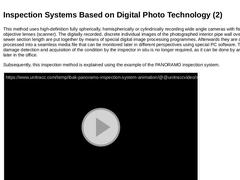
|
This method uses high-definition fully spherically, hemispherically or cylindrically recording wide angle cameras with fisheye objective lenses (scanner). The digitally recorded, discrete individual images of the photographed interior pipe wall over the entire sewer section length are put together by means of special digital image processing programmes. Afterwards they are digitally processed into a seamless media file that can be monitored later … |
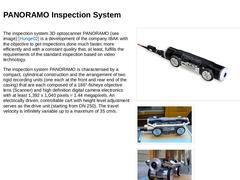
|
The inspection system 3D optoscanner PANORAMO (see image) [Hunge02] is a development of the company IBAK with the objective to get inspections done much faster, more efficiently and with a constant quality that, at least, fulfills the requirements of the standard inspection based on video technology. The inspection system PANORAMO is characterised by a compact, cylindrical construction and the arrangement of two rigid recording units (one each at … |
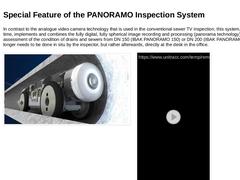
|
In contrast to the analogue video camera technology that is used in the conventional sewer TV inspection, this system, for the first time, implements and combines the fully digital, fully spherical image recording and processing (panorama technology) as well as the assessment of the condition of drains and sewers from DN 150 (IBAK PANORAMO 150) or DN 200 (IBAK PANORAMO) that no longer needs to be done in situ by the inspector, but rather afterwards, … |
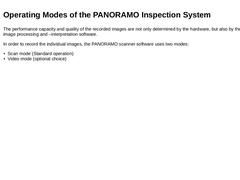
|
The performance capacity and quality of the recorded images are not only determined by the hardware, but also by the required image processing and –interpretation software. In order to record the individual images, the PANORAMO scanner software uses two modes: -
Scan mode (Standard operation)
-
Video mode (optional choice)
|
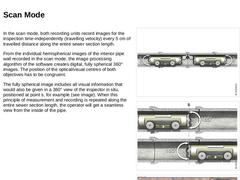
|
In the scan mode, both recording units record images for the inspection time-independently (travelling velocity) every 5 cm of travelled distance along the entire sewer section length. From the individual hemispherical images of the interior pipe wall recorded in the scan mode, the image processing algorithm of the software creates digital, fully spherical 360° images. The position of the optical/visual centres of both objectives has to be congruent. |
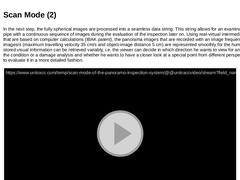
|
In the next step, the fully spherical images are processed into a seamless data string. This string allows for an examination of the pipe with a continuous sequence of images during the evaluation of the inspection later on. Using real-virtual intermediate images that are based on computer calculations (IBAK patent), the panorama images that are recorded with an image frequency of 7 images/s (maximum travelling velocity 35 cm/s and object-image distance … |

|
In addition to the perspective (full spherical) record, the computer-aided image data processing also allows a clear, flat (two-dimensional) unfolding of the photographed interior pipe wall (see images). Furthermore, the software allows for a true-to-scale representation of ovoid cross sections in processing and the measurement of obstacles that intrude into the pipe cross section in a perspective view [FI-IBAK]. (Image: Example of perspective view (… |
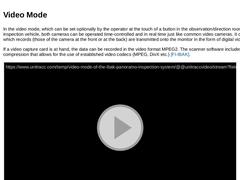
|
In the video mode, which can be set optionally by the operator at the touch of a button in the observation/direction room of the inspection vehicle, both cameras can be operated time-controlled and in real time just like common video cameras. It can be chosen which records (those of the camera at the front or at the back) are transmitted onto the monitor in the form of digital video data. If a video capture card is at hand, the data can be recorded … |
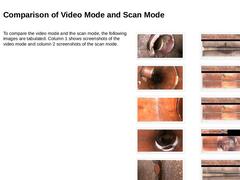
|
To compare the video mode and the scan mode, the following images are tabulated. Column 1 shows screenshots of the video mode and column 2 screenshots of the scan mode. (Image: Screenshot video mode - concrete sewer - damaged connection / connection incompletely integrated) (Image: Screenshot of video mode - vitrified clay sewer - protruding connection / connection incompletely integrated and longitudinal crack) (Image: Screenshot of the scan mode - … |
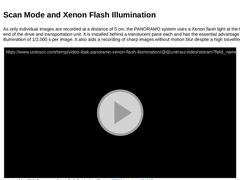
|
As only individual images are recorded at a distance of 5 cm, the PANORAMO system uses a Xenon flash light at the front and rear end of the drive and transportation unit. It is installed behind a translucent pane each and has the essential advantage of a very short illumination of 1/2,000 s per image. It also aids a recording of sharp images without motion blur despite a high travelling velocity. (Video: Video IBAK Panoramo - Xenon flash illumination) |
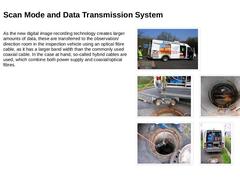
|
As the new digital image recording technology creates larger amounts of data, these are transferred to the observation/direction room in the inspection vehicle using an optical fibre cable, as it has a larger band width than the commonly used coaxial cable. In the case at hand, so-called hybrid cables are used, which combine both power supply and coaxial/optical fibres. (Image: PANORAMO inspection system in practical use - view of the inspection vehicle) (… |
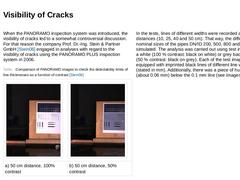
|
When the PANORAMO inspection system was introduced, the visibility of cracks led to a somewhat controversial discussion. For that reason the company Prof. Dr.-Ing. Stein & Partner GmbH [Stein06] engaged in analyses with regard to the visibility of cracks using the PANORAMO PLUS inspection system in 2006. (Table: Comparison of PANORAMO images to check the detectability limits of line thicknesses as a function of contrast.) In the tests, lines of different … |
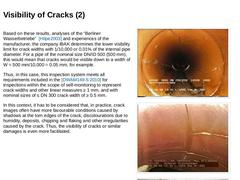
|
Based on these results, analyses of the “Berliner Wasserbetriebe” [Hilpe2003] and experiences of the manufacturer, the company IBAK determines the lower visibility limit for crack widths with 1/10,000 or 0.01% of the internal pipe diameter. For a pipe of the nominal size DN/ID 500 (500 mm), this would mean that cracks would be visible down to a width of W = 500 mm/10,000 = 0.05 mm, for example. Thus, in this case, this inspection system meets all … |
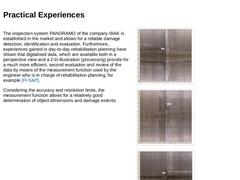
|
The inspection system PANORAMO of the company IBAK is established in the market and allows for a reliable damage detection, identification and evaluation. Furthermore, experiences gained in day-to-day rehabilitation planning have shown that digitalised data, which are available both in a perspective view and a 2-D-illustration (processing) provide for a much more efficient, second evaluation and review of the data by means of the measurement function … |

|
(Image: Picto Unterhalt) A survey answered by users of the system [PANO2004] showed that, compared to standard pan and tilt cameras, the inspection performance of the PANORAMO inspection systems is up 100 % higher, resulting in a higher efficiency at an appropriate degree of utilisation. The tasks of the inspector are limited to the insertion and extraction of the camera and the monitoring of its functions during the inspection. The damages are coded … |
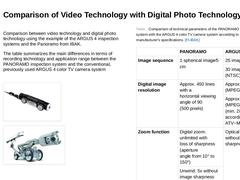
|
Comparison between video technology and digital photo technology using the example of the ARGUS 4 inspection systems and the Panoramo from IBAK. The table summarizes the main differences in terms of recording technology and application range between the PANORAMO inspection system and the conventional, previously used ARGUS 4 color TV camera system (Image: Inspection system PANORAMO) (Image: Height adjustable trolley with side guide for oval pipes) (… |
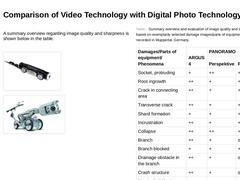
|
A summary overview regarding image quality and sharpness is shown below in the table. (Image: Inspection system PANORAMO) (Image: Height adjustable trolley with side guide for oval pipes) (Table: Summary overview and evaluation of image quality and sharpness based on exemplarily selected damages/parts of equipment/phenomena recorded in Wuppertal, Germany) |
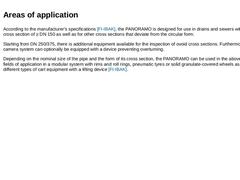
|
According to the manufacturer’s specifications [FI-IBAK], the PANORAMO is designed for use in drains and sewers with a circular cross section of ≥ DN 150 as well as for other cross sections that deviate from the circular form. Starting from DN 250/375, there is additional equipment available for the inspection of ovoid cross sections. Furthermore, the camera system can optionally be equipped with a device preventing overturning. Depending on the nominal … |

|
|
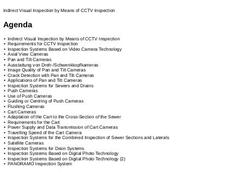
|
|
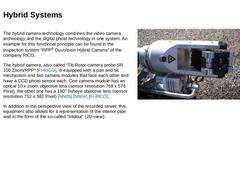
|
The hybrid camera technology combines the video camera technology and the digital photo technology in one system. An example for this functional principle can be found in the inspection system “RPP® DuoVision Hybrid Camera” of the company RICO. The hybrid camera, also called “Tilt-Rotor-camera probe SR 100 Zoom/RPP” [FI-RICO], is equipped with a pan and tilt mechanism and two camera modules that face each other and have a CCD photo sensor each. One … |

|
The recording of the damage is done conventionally via the stop and go principle during the (inspection) trip from the starting manhole through the sewer by means of an optical 10 x zoom objective lens with 24 watt camera lighting and the separately operated additional spotlights (with a total of 4 x 20 W). In the process, the inlets/branches, pipe connections/sockets and damages are recorded by pan (up to 270°) and tilt (unlimited) movements of … |
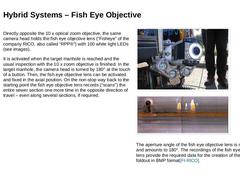
|
Directly opposite the 10 x optical zoom objective, the same camera head holds the fish eye objective lens (“Fisheye” of the company RICO, also called “RPP®”) with 100 white light LEDs (see images). It is activated when the target manhole is reached and the usual inspection with the 10 x zoom objective is finished. In the target manhole, the camera head is turned by 180° at the touch of a button. Then, the fish eye objective lens can be activated and … |
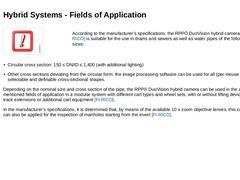
|
According to the manufacturer’s specifications, the RPPÒ DuoVision hybrid camera system [FI-RICO] is suitable for the use in drains and sewers as well as water pipes of the following nominal sizes: -
Circular cross section: 150 ≤ DN/ID ≤ 1,400 (with additional lighting)
-
Other cross sections deviating from the circular form: the image processing software can be used for all (per mouse click) freely selectable and definable cross-sectional …
|